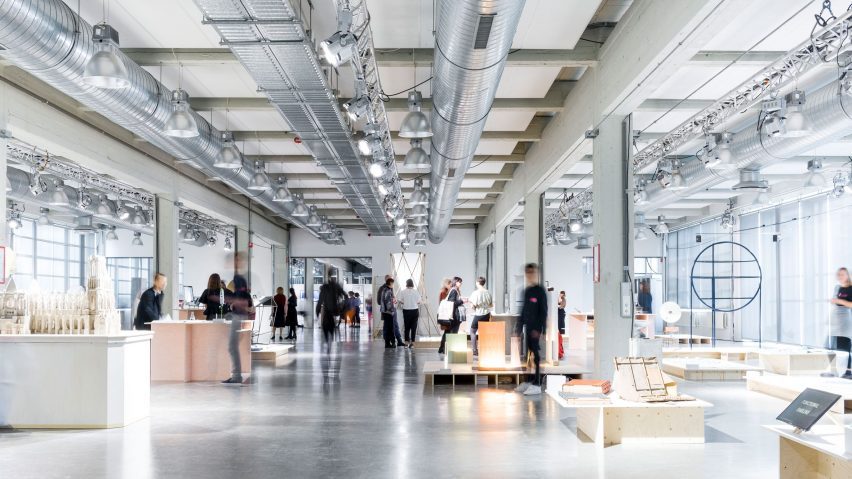
"Turning away from the serious provides a welcome breath of air"
What were the key themes that emerged at Dutch Design Week 2017? We asked six graduates on Design Academy Eindhoven's design writing masters course to give their takes in essay form. Their answers include gigantism, post-humanism and absurdism, the latter exemplified by cushions based on Kim Kardashian's "butt-selfies".
Dezeen used the week to highlight the increasing number of designers tackling the world's big problems, through our Good Design for a Bad World talks series. But students studying the Design Curating and Writing masters course in Eindhoven had other ideas...
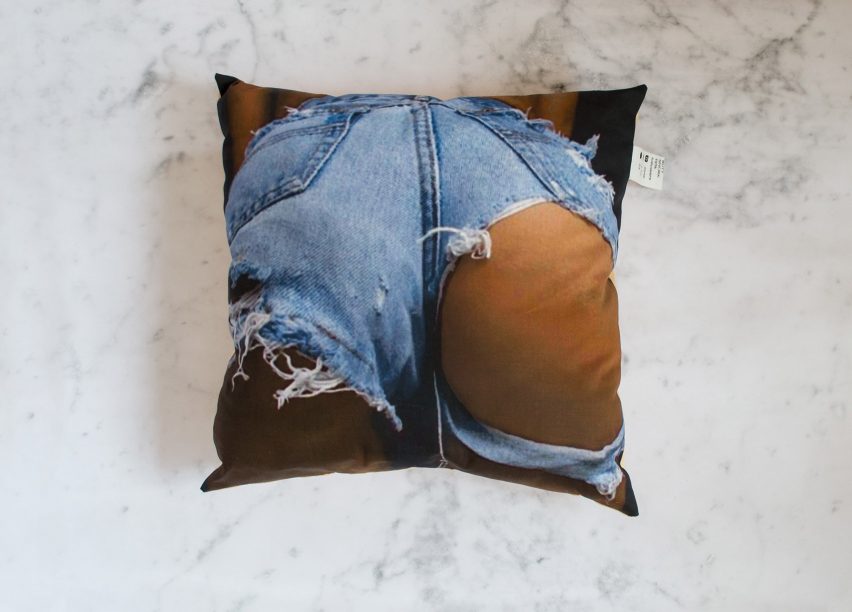
"Turning away from the serious provides a welcome breath of air"
With some designers embracing gloomily serious topics at Dutch Design Week, it’s no wonder that others decided to lighten the mood and embrace the absurd, writes Lara Chapman.
"Life is meaningless," said comedian, writer, and musician Tim Minchin upon collecting his honorary doctorate from the University of Western Australia in 2013. With a grin, he continued, "I am actually rather romantic and here's my idea of romance: you will soon be dead. Life will sometimes seem long and tough and God it's tiring. And you will sometimes be happy and sometimes sad and then you’ll be old and then you'll be dead."
Perhaps Minchin was onto something. In the wake of World War II, Albert Camus, a French philosopher, brought light to this type of cynical malaise, and recommended that we accept and embrace the absurd nothingness to which we are all condemned with a touch of humour. In light of recent political events, and an increasing sense of doom and gloom, a number of designers at the 2017 Dutch Design Week took Camus' advice and embraced the bizarre, ridiculous and peculiar.
This is not to say that DDW was not overwhelmed with projects tackling things like climate change, refugees, terrorism, depleting fossil fuels, pollution, food shortages, egotistical presidents, and emerging dictatorships, just to name a few. Designers are nobly donning their thinking caps and sharpening their proverbial pencils in order to tackle these problems. Searching for meaning, answers, or problems to solve, DDW seemed to say that everything must have a function.
However, according to Willem van Doorn, "sometimes you just have to make things because it's fun." His Kerstboomkanon (Christmas tree cannon) project, the result of a collaboration between van Doorn and Leon De Bruijne, shoots Christmas trees up to 64 metres through the air just using bike pumps. Demonstrated daily, the orange canon's oversized, goofy wheels and horn-like nose makes it appear to be a cartoon brought to life.
The hybrid object combines two, seemingly disparate products: one, a weapon of destruction used in warfare, and the other, a symbol of celebration. Similarly, its brother, a smaller blue cannon, shoots confetti in a display of violent merriment. Bizarre in both concept and style, the canon has no particular purpose, but the ability to make people smile is not to be underestimated.
The brave move of turning away from the serious and provocative in favour of creating things simply for the joy of it provides a welcome breath of fun air. Joseph Grima, architect, critic and newly appointed creative director of the Design Academy Eindhoven aptly described DDW as a "design circus" with a chaotic yet intriguing mix of ideas and people, as well as somewhere that is "able to generate a critical perspective." However, in this criticality, the circus needed a few clowns to spread some cheer and let us take a break.
In The Human Scanner by Daniel de Bruin and Papersmith Studio, visitors are invited to experience the journey of a suitcase in an airport, "just for fun". Sitting in a plastic crate, transported along an 11-metre mechanised conveyor belt, and through a "scanning machine" made of flexing mirrors, laser beams, and concertina cladding created an immersive experience that left one bemused and giddy rolling out slowly through the rubber flaps and into fresh air.
Tongues in cheek, the designers stated that they accept no responsibilities for the inaccuracy of the scanning device. After all, people are not suitcases so they've never been through a real scanner. Their humour aims to serve as an antidote to ever more security measures, not only at airports, but also in other, more routine aspects of daily life. The project hints at a critique of this constant surveillance, but in the end, it is mostly just good for a chuckle.
Taking a somewhat different approach, Melanie De Luca, a graduate from the Design Academy Eindhoven, reflects on the absurdity of society in a serious research-led project. Post Butt examines the peculiar trend of "belfies" (butt-selfies) popularised by celebrities like Kim Kardashian. By printing overtly sexualised belfies onto cushions, De Luca juxtaposes a notion of comfort typically associated with plush objects with the awkwardness of lying with your head on a carefully crafted photo of someone's derrière. This strange experience allows one to reflect upon and question the obscure desire to share one's behind on social media. De Luca comically prompts us to ask why we behave in such a way, but also to enjoy the strangeness of the times in which we find ourselves.
Being silly may seem frivolous to some – wasting resources, time and money with no overt functional agenda. However, if we take this approach to life then we risk finding ourselves in a cultural drought with even more problems to fix. Think of novels, theatre, music and art. Sometimes they deal with crucial issues and attempt to solve them but mostly they are created for joy, for fun, for beauty. They create meaning and teach us to see the world in a different light. To imagine impossible things. To consider alternatives. Can design not contribute to this or will it be forever limited in the grips of resolving the mess that humans have made? I think it's time to start taking fun seriously.
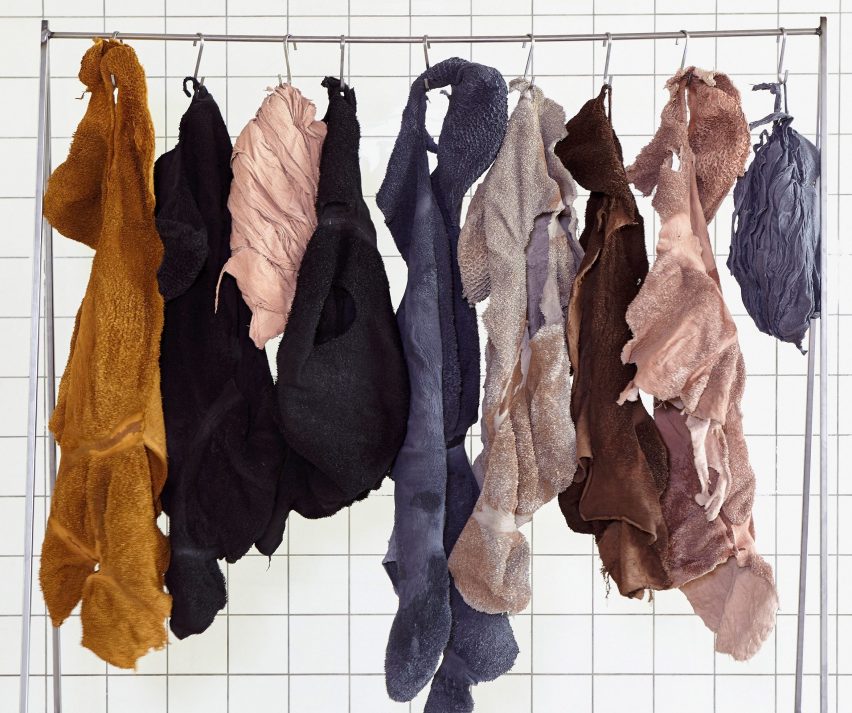
"Designers are digging deep into the wastelands of an exhausted earth"
Designers are increasingly using the stuff we throw away as a raw material. But for this strategy to be successful, waste needs to be alchemically transformed into things of value, writes Esteban Gomez Rosselli.
Waste is constantly being produced. Beyond the tons of plastic waste so often prioritised, there are also piles of shit, guts, and other remains. These organic leftovers resist the indifferent rationality of artificial materials and remain immutably alive (just think of the saying, a shit-ton, as a resistance to the quantifiable). Scraps are rotting as we speak. Because of this delicate timespan, repurposing this kind of waste requires thinking how it can be machinated from the moment it is produced.
Yet in conceiving of waste as product, we should not allow its shelf life to pressure us into unsatisfactory uses for it. Any indiscriminate grinding together of all that remains, as well as any undifferentiated reduction to the simplest, cheapest, and plainest goo or compost, is inadequate. It is not good enough just to do something with it; waste needs to be re-conceived in relation to our cultural views.
Animal stomachs, blood, and even their droppings and remains were among the leftovers through which various designers rummaged throughout this year’s edition of Dutch Design Week, reminding us that there is great value in unwanted remains, which can be unearthed under careful and creative explorations. They reflect a trend reminiscent of how American Indian tribes in the Great Plains were said to resourcefully use every part of the buffalos they would kill.
These designers envision a repurposing of waste that is heavily reliant on fostering a know-how capable of distinguishing what each part may be valuable for. Having dissected this animal of cultural importance, it is not just what, but how waste is being transformed that allows for quality in repurposing it. The amplitude of possibilities is determined only by the creativity and research invested into it.
Reminding us how waste is a notion contingently embedded in culture, Billie Van Katwijk used cow stomachs being discarded in slaughterhouses to develop luxurious leathers. Her project Ventri (which means "stomach" in Latin), exhibited in the Design Academy Eindhoven graduation show, encompassed an extensive exploration of material properties until she developed a method that would allow her to rescue the beauty she found in "the natural structures of cow stomachs, each of which has different shapes, forms, and textures that would otherwise turn into flat skins in the tannery machines." Through the great precision required, Billie echoes her concern "about how we perceive waste and value," and its relation to know-how.
Basse Stittgen, another Design Academy Eindhoven graduate showing at the school's MINED graduation show, also worked with waste from slaughterhouses in Blood Related, which showcased a wide variety of objects made from blood-made bioplastic. Stittgen claims "everything from the animal" should be used, instead of routinely discarded. While the objects, which include an egg holder, a jewellery box, and a record that plays the heartbeat of a pig, evoke the meaningful connotations of blood, he neuters it into a simple material for artificialised production. Basse explores the possibilities blood may offer as a material while reminding us of the heavy symbolic implications a material carries.
Perhaps the most ambitious initiative towards positive environmental impact was the award-winning Mestic project, named after the word for manure in Dutch, in which cow dung is processed into a biomaterial with applications varying from textiles to plastic.
While cow manure is a waste product commonly repurposed to fertilise the fields, it has become a strong pollutant due to excessive production. Jalila Essaïdi’s project helps dairy farmers remain within pollutant regulations by repurposing their remnant waste. While alleviating dairy farmers from the strains of the regulation, it also incentivises them to upgrade the quality of their stocks' diet for better cellulose content so that better manure for the material can be produced, all the while further reducing pollutant emissions.
The project approaches waste as part of a machinated system capable of being retooled into a circular economy. Mestic is a detailed convergence of scientific and creative know-how combined with a complex understanding of the systems of waste production. Jalila goes beyond just using every part of the animal, and moves towards making the animal more productive, even though it is waste.
Two projects in the Embassy of Food seemed somewhat more predatory. Surrounding the concern of the future of food, both Human Hyena by Paul Gong and The Future Sausage by Carolien Niebling seems to explore devouring the unwanted.
They take waste to the limit in quite different ways, while emphasizing a sense of scarcity. In Human Hyena, waste no longer needs to be transformed. Instead, synthetic biology and sense prosthetics modify the human body would allow people to scavenge for food and consume decaying waste pleasurably. The Future Sausage prepared unwanted cuts of meat in the style of various, more common food dishes, which would allow them to be consumed pleasurably. While both projects advocate for consuming more of the animals we kill through shifting our understandings of waste, they also show that it is not only us that are predatory, but scarcity itself which may devour us.
The future concerns correcting the irreversible consequences of an irresponsible past. Now that it no longer seems remote, and that the universe appears finite, facing our cultural understandings of waste is imperative to rescue that which we would otherwise have discarded. Designers are digging deep into the wastelands of an exhausted earth in trying to re-conceive their relation to waste. What they show is that discussions on responsibly repurposing waste need to be accompanied with a sense of valour. Some waste, like organic matter, can be cultivated and machinated from the moment it’s produced into something valuable. After all, waste is not only produced through consuming, but through culture. It is time to rethink how life relates to waste: it is time to reincorporate value into it.
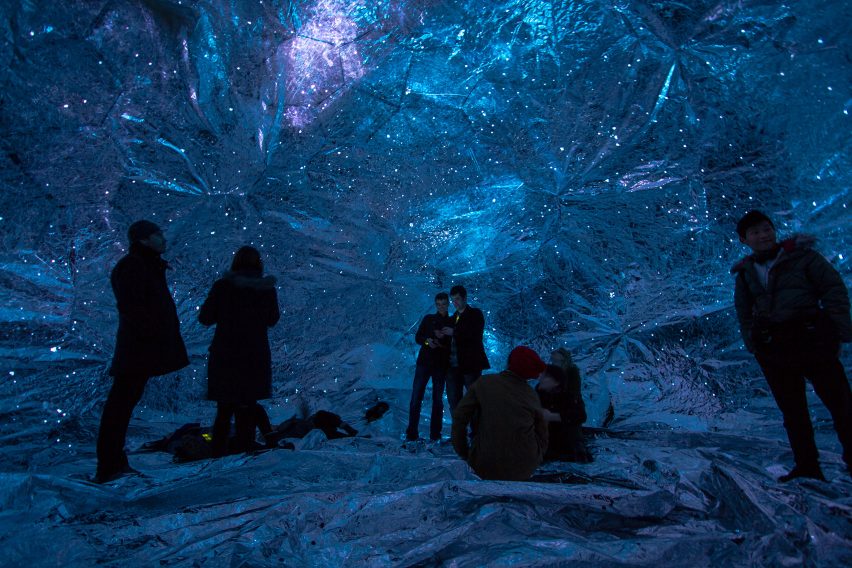
"Designers set out what a post-human lifestyle might look, feel and taste like"
What would the world look like without people? Designers are already investigating, writes Tiiu Meiner.
Technological advance has granted mankind with a precarious understanding of itself as the superior species on planet Earth. Indeed, with 54 per cent of the globe's population residing in concrete jungles, it is almost easy to forget that there is a world outside of our immediate urban aspirations.
Yet we dream of lush greenery and expensive holidays getaways into nature. Why, then, are we expunging it from our immediate realities? As we find the human being increasingly extracted from nature, designers at Dutch Design Week 2017 set out to envision what a post-human lifestyle might look, feel, smell, sound, and even taste like.
KUR, a project by Timo Wuchner, a graduate from the Design Academy Eindhoven, draws upon the health benefits of salty sea air on human respiratory and emotional systems. Salt water has been associated with longer life spans and balanced psychological states. Wuchner's design packages susceptible coastal environments for redeployment in our rapidly developing urban systems.
With a steady stream of saltwater dripping down a maze-like installation of blackthorn twig walls, Wuchner replicated the phenomenal conditions of a coastal breeze. As water droplets slowly evaporate, the air takes on a quality of the sea, serving as a refuge from urban pollutants. While his installation at Dutch Design Week was merely a smaller scale model of the full maze, his vision is for the walls to be erected in a public square or park.
Rather than being concerned with questions of biological health, Osmo by Loop.pH treats more anthropocentric, if not spiritual concerns of mankind’s displacement. Responding to the increasingly prevalent phenomena of light pollution, the designers charted nearly 3,000 stars and planets on the skin of a gigantic inflated silver bubble. Having re-created the cosmos, visitors are able to (re)discover the beauty of constellations and the night sky.
Beyond its somewhat cynical suggestion that the solution to light pollution would be to create a new cosmos, Osmo alludes to the problematic nature of design within a post-human world. Reformatting the beauty and function of nature to fit man-made urban environments is surely no appropriate replacement, not to mention a preventative measure, for the destruction of the real thing.
But Osmo bubbles are not being built around cities as a staple replacement for the starlit night, but rather as an installation at an event such as Dutch Design Week. Loop.pH did not set out to intentionally replace the universe, but rather their attempt to create a reinvented cosmos through 'Osmo' has an underlying political experience for the audience. To create a comparison between the design and the real thing, and to question whether it would ever be something they would want in their lives.
On the potential for design to act politically, or even to redesign politics, artist and engineer Nathalie Jeremijenko notes that: "the relationship of design to political reformulation is tied to the question of institutionalisation. Designers themselves can produce instances of alternate forms or structures of participation, snapshots of possibilities, but until they enmesh into an institutional continuity they remain atomised."
This approach is evident within the project by Studio Solarix, who designed a grid of neutral coloured, leather-covered solar panels and LED light squares, to tackle issues of unsustainable living conditions in urban environments. Large solar panel projects such as Tesla's solar roof have been initiated, but are still in the making and the dated aesthetics of solar panels deter creative interpretation from architects and designers. By varying dimensions and incorporating fascinating LED lighting that reacts to the surrounding environment, Studio Solarix aim to assimilate their solar panels further into the creative processes of architects by giving them more freedom to design.
The project also incorporates nature by integrating solar energy into the urban energy cycle. Studio Solarix emphasises the need for solar panels to go beyond a stationary "thing" on the urban building rooftops, and to be much more incorporated in city-planning and design. The project encourages creative approaches to sustainable city design, utilises solar energy for powering buildings and LED street lighting, thus incorporating, rather than rendering irrelevant, the origin of its natural powers.
Designers at the 2017 Dutch Design Week demonstrated made the case that post-human cities require nature to be reimagined. Whether by using design to optimise the utilisation of its resources or by transplanting its phenomenal effects to raise awareness of public health, it is imperative to reconsider the post-human, post-natural future of our cities.
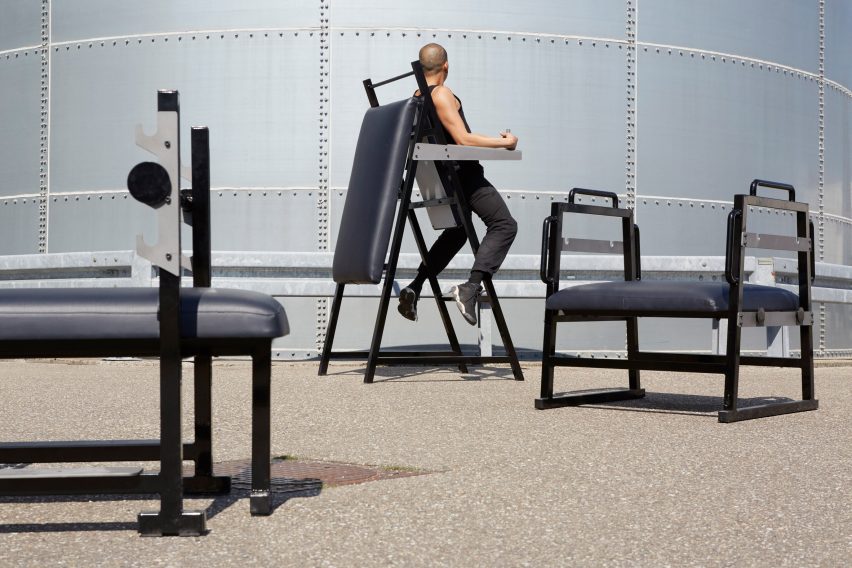
"Social relations write our behaviours"
The objects that surround us make us behave differently. Aline Fantinatti identifies designers who are exploring the influence of things, and devising ways we can escape from it.
Our bodies learn through repetition. Movements are stamped into it and its memory. We don't need to think about what we are doing to do it; we just do it. During Dutch Design Week 2017, numerous design projects echoed and explicated the philosophical idea that social relations write the behaviours of our bodies. The projects challenge the accepted idea that our gestures, postures, and attitudes are shaped naturally, and demonstrate design's potential – and responsibility – not only to raise awareness about how our bodies are shaped, but to teach them how to do things differently.
Spaces and design objects work as day-to-day life manuals that teach us how to walk, eat, dress, and, ultimately, define ourselves. In Design Academy Eindhoven's graduation show, Dress_De_Code by Dasha Tsapenko, visually translates the relation between design, space and the movements we incorporate into our everyday routines. Tsapenko looks over dressing up. If the memory of such banal movements was suddenly erased from our minds, the wooden geometric structures developed by the designer would teach us the ABC of covering the skin with textile shapes.
Built to human scale, the lacquered surfaces of the black set squares hold stretched pieces of cloth. Each of their angles tell us how to position or bodies over them. Each opening indicates where to put legs, heads and arms through. Hook and loop fasteners complete the daily choreography of wear. Her geometric, scenography forms open space for a performative illustration of how our unwatched gestures and behaviours are moulded by the interference of objects and space. Beyond our gestures, design also determines the way we dress and how we load our bodies with information before performing our identities in the social space.
For writer and philosopher Paul Preciado, the development of design and architecture is not a benevolent gesture, but rather serve as instruments for what he calls "social orthopaedics," tools that discipline and control free bodies. According to Preciado, American postwar suburbs, for instance, functioned to lock housewives in their houses at the edge of cities while granting men an animalistic spirit with stylised fin-tailed cars.
Jonathan Ho's Spornosexual project challenges gender binaries by caricaturing contemporary alpha-male identity. His fitness equipment made from powder-coated steel frames and upholstered with vinyl padding looks almost identical to those we might see in fully equipped luxury hotel gyms. But instead of being designed for bodybuilding, small alterations made to their proportions make the equipment perfectly designed for use in different sexual positions. The objects form part of a wider project called Fetishising Masculinity. Comprised of an elegantly textile glory-hole wall and a leather jumpsuit, Ho bravely draws our attention to the urgency of questioning the violence inherent to contemporary male identity.
Roxanne Brennen's Dining Toys investigates tableware such as knives, forks, and spoons as a form of disciplinary design and proposes new ways of eating what is on our plates. In reminding us that the popularisation of tableware is historically linked to the manufacturing of modern, civilised behaviour in western culture, Brennen's ceramic tools break away from etiquette and introduce new performances, like sucking, licking, bondage and foreplay. Dining Toys establish a more libidinal relationship with food, one of the most visceral human experiences. Losing control while eating can, Brennen hints, be just as pleasant an experience as it is in sex.
The dissemination of industrial design represented the refinement of control technologies that invisibly penetrated into our bodies to shape our attitudes. Please Touch, part of the Embassy of Intimacy, was an amusing provocation that compelled visitors to become more conscious about how behaviour is subtly shaped by outside influences. The anonymous work played with a visual memory of the "fragile" tape we are used to placing over our check-in luggage.
Nevertheless, a closer look at the familiar red colour code and bolded utilitarian typeface invited us to an opposite reaction: bodily approximation. Several rolls charged with the red sticky tags were placed over a post-office package wrapping-like counter, centred around the other installations in the exhibition. The tags were free for anyone to take and soon became viral. Over public trash bins, light poles, backpacks, clothes, bottles of water and also among trendy laptop stickers, the tags spread everywhere throughout Eindhoven.
DDW 2017 showed us that we are putting ourselves on a path towards a future in which our entire agency as human beings is transferred to omnipresent technologies. Imposing new uses of the body is one of the few, yet paradoxical ways of encouraging the adoption of a more free, creative, and perhaps even disobedient, life.
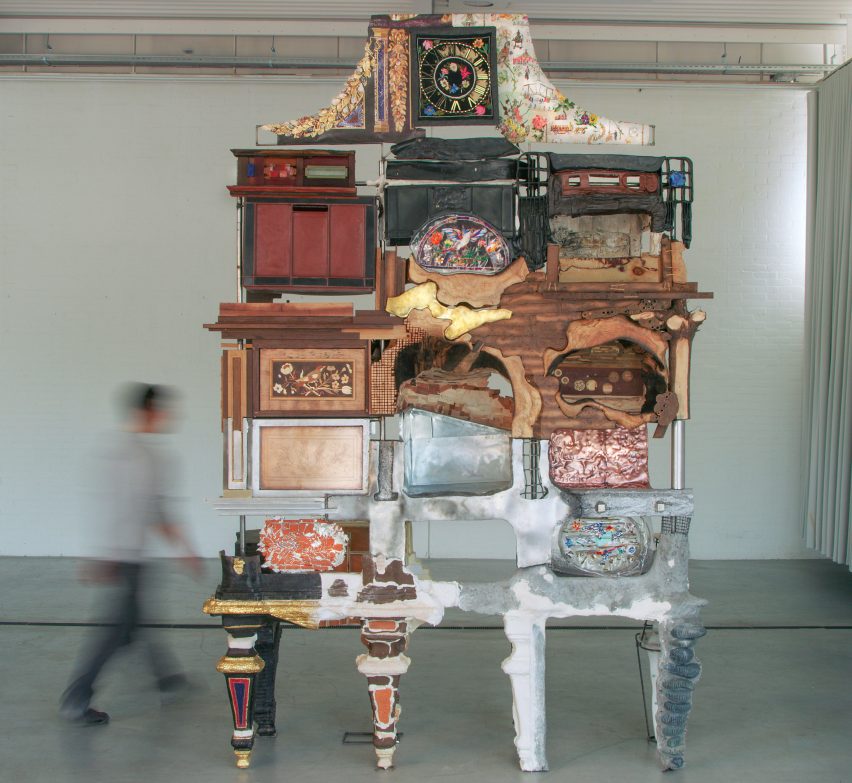
"Gigantism was one of the characteristics of Dutch Design Week"
This year, designers were expressing themselves with ever-larger creations, argues Heloise Charital.
Is man still the measure of all things? The ziggurats and Egyptians pyramids, the height of gothic architecture, New York and Tokyo structures in the 1980s or Dubai and Shenzhen today testify to an oversized architecture. Artistic examples in which the objects of man exceed the dimensions of its figure are not lacking either, from Michelangelo's David to Louise Bourgeois’ spiders.
What has resulted, in the field of art, is the creation of a particular type of event designed for large projects, such as the well-named Monumenta in the Grand Palais or Art Basel Unlimited. If art has aspired to the architectural dimension, as Hal Foster revealed in The Art-Architecture Complex, we could ask whether, and in what way, design aspires to a certain gigantism either? What can be read within the megalithic scale of Studio Job's teapot of the Last Supper and other excesses?
The gigantism of design was also one of the characteristics of Dutch Design Week 2017, beginning with Kostas Lambridis' graduation project, whose master is none other than Nacho Carbonell, designer of giant chairs or lamp.
Elemental Cabinet by Lambridis would be a prime example of monumental design, if such a genre existed, in his reinterpretation of the legendary form of the 18th century Badminton Cabinet. The original piece copied by Kostas of 3.86 metres high and 2.32 metres wide made of ebony, ivory, pietra dura and semi-precious stones, and became famous through its real merchantability that defied the laws of the art market.
The piece by Lambridis has the same dimensions except that it alternates poor and precious materials, and uses both new and old techniques. The designer questions the very idea of creation, opposing the urge to create aesthetic and precious objects with the desire of getting closer to nature. In full awareness that it took 30 Florentine craftsmen six years to realise the initial cabinet, Lambridis himself surpasses the ordinary mortal with the immense work that he has made on his own. Almost four meters tall, rich of colours and baroque materials, its grandeur makes one feel small when standing in front of it.
Similarly, the Polymorf collective, which is made up of designers Marcel van Brakel, Fredrik Deurinck and Mark Meeuwenoord, presented their installation Famous deaths at the TAC (Temporary Art Center) as an immersive and participatory exhibition that aimed to bring the conditions of death to life by reliving those of famous characters from history. In order to do so, they have – through thorough research – reconstructed the smell that should have surrounded the characters at the time of their disastrous fate. Sounds and perfumes are then diffused to the audience, which take place – one at a time – in morgue coffins, whose refrigerated character is no longer required. Materialising the heavy atmosphere, the coffins also prevent visual stimulation to further stimulate our response. Their grey presence occupying a massive place in the piece intrigues the spectator who does not expect to encounter this type of object in a design week.
Equally perplexing is the Autonomous Machine Gun presented by Freerk Wieringa in the exhibition Manifestations: Will the future design us? a titanic robotic arm holding a gun facing the audience is presented. Used as a "wake-up call, as autonomous weapons are every day more frequently used and abused in war zones and hostile borders". According to the designer, the piece also questions technology when it tends towards automation. Turning, folding or unfolding, the arm, covered with a military print, almost reaches out to the public from which it is separated by barriers.
It is the public who can control the weapon, which functions through a brain scanner reading the minds of people watching. Here, design relays the feeling of fear and impotence when facing a technology that we create but that surpasses us. Indeed, the piece whose technological strength contrasts with the fragility of the human condition, which can be suddenly abolished, gives the item a nightmare-like appearance.
Excess in design expresses itself through creations that surpass human proportions and confer extraordinary powers to designers, which are illustrated by the limitlessness of their work. Surpassing of a certain height and weight provokes almost instinctive feelings of fear and dazzle, which designers are using to generate their ever-growing discourses. Design is big in every sense of the word; in size to reflect the big preoccupations of the creators that seem to be settling in. If grand often evokes a solid and impressive aspect, let's hope that it is not a colossus with feet of clay whose appearance hides a weakness of reasoning.
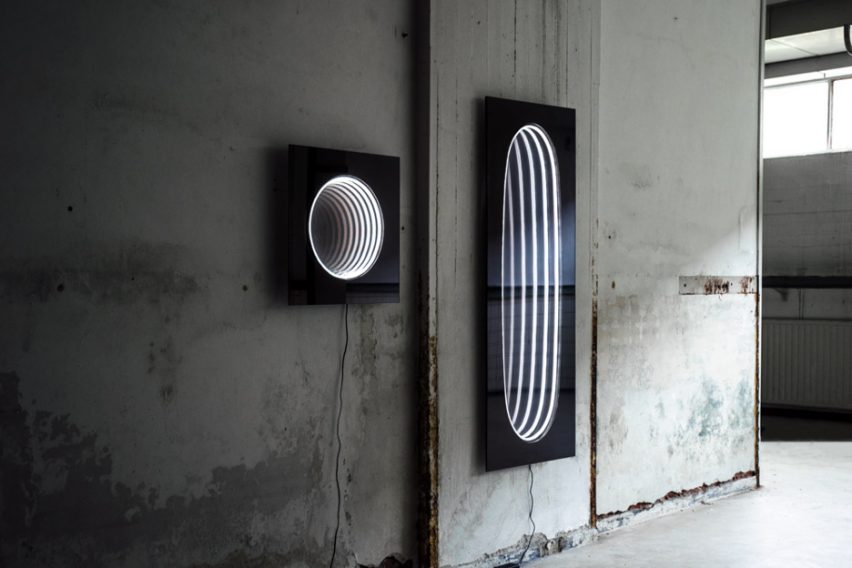
"Humans are more likely to empathise with creations that look like themselves"
Poetic design uses technology to help us see deeper into ourselves, argues Mara Siegel.
This year's Dutch Design Week held a mirror up to current concerns and scenarios. One saw not only what people create, but also how they will be shaped by new technologies in the future. Technologies enhance identities and make them possible. Identities in turn conceal technologies. The objects and installations on display are not always concerned with concrete design, but importantly with a poetic, almost artistic approach to what design could be – the mirror of humanity and poetic design as an instrument for cultural engagement.
If one considers the impact that these design objects and installations have on yourself, you see a common denominator – they all lead you to find yourself in an unfamiliar terrain. Poetic design and the view into the unknowable scratch the surface of self-certainty. Without us knowing it, we are touched, shocked and left alone with a sense of cluelessness and maybe even inspiration.
An object with such an effect due to its peculiarity is Speculum by Simone Smelt, exhibited at the Design Academy's graduation show. Soft tone black mirrors mounted on the wall let the viewer unnaturally look into a deep illuminated tunnel which, from a logical perception, should not be there. The two interactive mirrors play with light and dimension, creating a mesmerising channel of light that trigger the visual perception. Touch the mirror and the light wormhole opens up, touch it again and the tunnel changes its course. It is an optical illusion: a non-existent tunnel on the wall – a tribute to Alice in Wonderland. Smelt creates a feeling of unknowingness – it raises the question of whether we really have the urge for space, or whether a spatial feeling is enough to ease our mind.
Displayed at this year's Hardcore exhibition, The Reinforced Light Object by Hans van Sinderen & Fabian Briels features a similar aura. The material of the luminaire device creates an uneven, visually flowing surface, which gets enhanced by a LED light source. It embodies the strength of glass and an encapsulated net structure, which, in addition to the light behind it, creates not only a fragile but reinforced compound, and a bionic shape, as if a cloth had been placed on a frozen sea and this shape was captured.
Departing from the use of silicone and LED lights, both having fragile qualities, the object combines these materials and principles together and creates a reinforced light object. It gives the user endless possibilities for the placement of the product. Almost poetic – in the sense that a beauty is created through pictorial language and stimulation of the senses that can hardly be rationally explained.
We can ask, what excites us in undefined forms and abstractions of everyday objects, such as mirrors and lamps? It is the absence of being able to identify completely with something, but still being emotionally touched by the inaccuracy of the object itself. There is a lack of a static sense of belonging because at first glance you don't see anything that is familiar from your everyday life. Only with analytical force can such concepts be described in detail.
Design is not only designed by, but also shapes, people – for example, by the way in which an object dictates its handling by its form. But what if an object does not dictate anything? The unarticulated form, smooth surface or non-identifiable design of the Reinforced Light Object, for example, eliminates friction, removing bodily and logical sensation.
What are the ethics or morals of this object? What happens if we can't assign anything to it and how do we position ourselves against it? Good design is an "ethic rather than an aesthetic," as the British architects Alison and Peter Smithson put in the 1950s. Its quality allegedly comes from the denial of any waste and the direct presentation of the fact – the search for the form and materials that most successfully meet all the practical requirements of production and function. Good design should be a surprise. No result is prescribed.
However, the stronger the visual effect and the soothing and dazzling surfaces are, the harder it will be to see whether good design actually does good. The ethics become a delusion. Such a kind of dazzling aesthetics could be seen at this year's exhibition of the Temporary Art Center, which showed design objects from various design graduates and offices.
Esmay Wagemans' New Humanity exhibit contains of a frighteningly real-looking female bust, modelled after a real person. The designer claims that her project raises questions of the identity shift between robot and human. Are robots becoming us or are we becoming robots? New Humanity shows that we have already made ourselves a product that needs to be observed and points to technological developments that give us the opportunity to become our own creator, but also create a hyper-self awareness of the body.
Humans are no longer strictly nature, but also a product of mechanisation. A human replicate is the most common interface, since humans are more likely to empathise with, and relate to, creations that look like themselves. By being more human, robots are more accepted by human, the designer says. With her project she points towards a society, in which the make-able human transformed from a disturbing fear image to a desirable ideal image.
Poetic design can be both, an instrument that opens up the view into the unknown and thus draws attention to the view of one's own perception of beauty, use and allegiance, but similarly, an unsuccessful provocation that contributes to the fear of the future and does not in any way productively advance what is happening. A trend of poetic analogy emerges, which creates premonitions without insisting on finality – away from proposals for solutions and towards the urge of ones own desire to know.